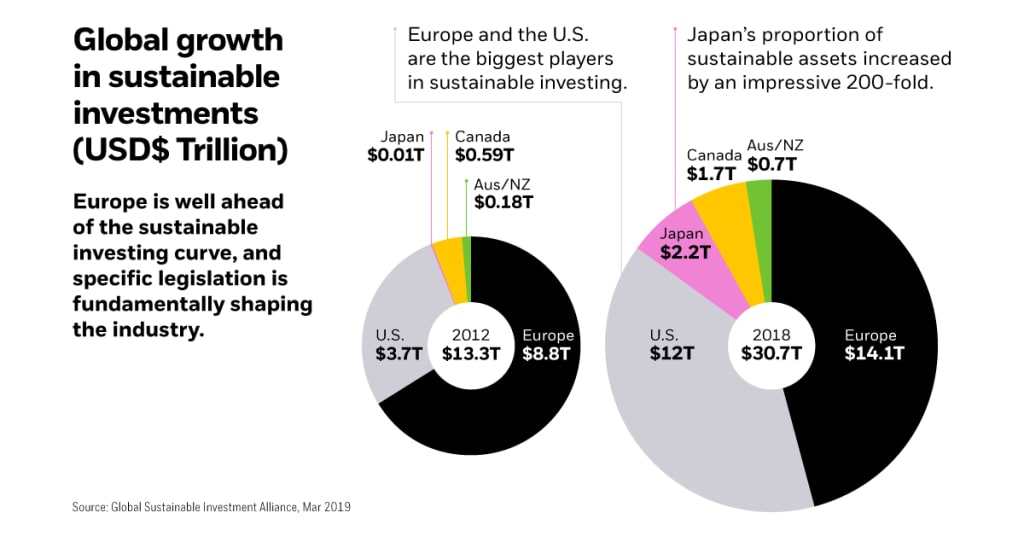Aligning financial goals with environmental and social values
Sustainable investing

I. Introduction
A. Understanding Sustainable Investments:
Sustainable investing, also known as socially responsible investing (SRI) or impact investing, is an investment approach that aims to generate financial returns taking into account environmental, social and governance (ESG) factors. It aims to align investors' financial goals with their values by supporting companies and projects that have a positive impact on society and the environment.
B. The importance of aligning financial goals with environmental and social values:
As the global community faces urgent challenges such as climate change, natural resource depletion, social inequality and corporate governance failures, individuals and institutions increasingly recognize the importance of investing in sustainability and addressing these issues. By aligning financial goals with environmental and social values, investors can drive positive change in pursuit of financial gain.
II. The rise of sustainable investing:
A. Growing awareness and concerns:
Over the past decade, public awareness and concern for environmental and social issues has grown significantly. People are more aware of the implications of their investment decisions and demand more transparency and accountability from companies. This awareness has fueled the growth of sustainable investing.
B. Changing Investor Preferences:
Investors are increasingly looking beyond financial returns and considering the wider impact of their investments. They prioritize companies that demonstrate strong ESG practices, ethical behavior and positive social impact. This shift in preferences shapes the investment landscape and encourages the adoption of sustainable investment strategies.
C. Regulatory Support and Initiatives:
Governments and regulatory bodies around the world recognize the importance of sustainable investing. They implement policies and regulations that promote transparency, disclosure of ESG information and responsible investment practices. These initiatives support sustainable investments and encourage their growth.
III. Basic principles of sustainable investing:
A. Environmental, Social and Governance (ESG) Factors:
ESG factors cover a wide range of topics such as climate change, resource management, labor, human rights, diversity and inclusion, government independence and ethical governance. Sustainable investors analyze these factors to assess the sustainability and social impact of companies.
B. Positive screen and negative screen:
Positive screening involves actively selecting companies with positive ESG characteristics and following specific sustainability themes such as renewable energy, clean technology or social empowerment. Negative screening, on the other hand, means excluding companies that engage in activities that are considered harmful, such as tobacco, weapons or fossil fuels.
C. Effective Investing:
In addition to financial returns, impact investments also focus on creating measurable positive social or environmental impacts. Impact investors support organizations or projects that directly address social or environmental issues, such as affordable housing, clean water or sustainable agriculture.
D. Shareholder Advocacy and Engagement:
Sustainable investors are often involved with companies through active shareholder advocacy. They use their influence as shareholders to promote ESG good practices, promote transparency and drive positive change in companies. This engagement can include dialogue, voting on decisions and working with other investors to increase their influence.
IV. The benefits of sustainable investing:
A. Long-term performance:
Research shows that sustainable investing can lead to competitive financial returns over the long term. Companies with strong ESG practices are better equipped to mitigate risks, adapt to changing market dynamics and take advantage of new opportunities. By considering ESG factors, investors can improve their chances of achieving sustainable economic growth.
B. Risk management and mitigation:
Sustainable investing can help reduce risks associated with environmental and social issues. By avoiding companies with poor ESG practices, investors can reduce the potential negative impact of conflicts, regulatory changes or reputational damage. In addition, investing in companies that prioritize sustainability can improve sustainability to the environment or social disturbances.
C. Positive impact on society and environment:
Sustainable investing gives investors the opportunity to support companies that have a positive impact on society and the environment. By allocating capital to companies that address key challenges such as renewable energy, sustainable agriculture or social empowerment, investors can actively participate in finding solutions and driving positive change.
D. Improved reputation and brand value:
Sustainable investing is increasingly recognized as a strategic business method. Companies that demonstrate strong ESG practices and engage with sustainable investors often enjoy better reputations and brand equity. This can increase customer loyalty, improve employee retention and access to new markets or partnerships.
V. Challenges and Considerations:
A. Lack of standardization and metrics:
One of the challenges of sustainable investing is the lack of standardized ESG metrics and reporting frameworks. Investors often have difficulty comparing and evaluating the viability of companies, making it difficult to make informed investment decisions. Efforts are currently being made to establish consistent standards and improve the quality and availability of ESG information.
B. Balancing economic return and impact:
Sustainable investing requires finding a balance between financial performance and efficiency. While some investments may prioritize impact on financial performance, others may find a balance by considering both aspects. Investors should assess their risk tolerance, return expectations and alignment with their values when planning sustainable investment strategies.
C. Greenwashing and ESG dilution:
The growing popularity of sustainable investing has raised concerns about greenwashing, where companies misrepresent or exaggerate their ESG practices. Investors should go through thorough due diligence to ensure that companies adhere to established sustainability goals and are truly committed to ESG principles. Additionally, there is a risk of dilution as ESG terminology becomes mainstream and companies attempt to rebrand without significant change.
D. Limited investment opportunities:
Although the range of sustainable investment options has expanded in recent years, investors may still face limitations in certain asset classes or sectors. Some industries, such as fossil fuels or defense, may have less sustainable options. However, as sustainable investing continues to gain traction, the availability of investment opportunities is likely to increase.
Sustainable investment strategies:
A. Integrating ESG:
ESG integration involves integrating ESG factors into traditional financial analysis. By considering ESG risks and opportunities with financial metrics, investors can make more informed investment decisions.
B. Thematic arrangement:
Thematic investing focuses on specific issues of sustainability, such as clean energy, water scarcity or gender equality. Investors can allocate capital to companies focused on these issues, enabling targeted impact and supporting innovative solutions.
C. Sustainable Index Funds and ETFs:
Sustainable index funds and exchange-traded funds (ETFs) track ESG-weighted indexes. These funds offer investors a diversified portfolio of companies with strong sustainability credentials and a passive investment approach to sustainable investing.
D. Effect on Mutual Funds:
Impact investment funds are specially designed to produce measurable positive social or environmental impacts in addition to financial returns. These funds offer investors the opportunity to directly participate in projects or organizations that address key sustainability challenges.
VII. Incorporating sustainable investing into your portfolio:
A. Identifying values and priorities:
Investors should consider their values, interests and the sustainability issues they are most passionate about. This reflection helps align their investments with their personal or institutional goals.
B. Set realistic financial goals:
It is important to set realistic financial goals when putting together a sustainable investment portfolio. Investors should consider their risk tolerance, time horizon and return expectations to design a sustainable investment strategy that meets their financial goals.
C. Conducting Due Diligence Investigation and Investigation:
Due diligence and research are key to choosing sustainable investment opportunities. Investors should check the sustainability reports of companies, ESG assessments and third-party analyzes to assess sustainability and evaluate their compatibility with their values.
D. Decentralization and distribution of assets:
The basic principles of portfolio management are diversification and asset allocation. Investors need to diversify their sustainable investment portfolio across asset classes, geographies and sectors to manage risk and improve opportunities for financial returns.
VIII. The future of sustainable investing:
A. Growing momentum and market growth:
Sustainable investing has gained significant momentum in recent years and will continue to grow. As investors increasingly realize the potential for financial returns and positive impact, the market for sustainable investing is expected to grow.
B. Integration into conventional investments:
Sustainable investing is no longer considered a niche strategy, but is increasingly integrated into mainstream investment practices. Traditional financial institutions incorporate ESG aspects in their investment processes and further strengthen the position of sustainable investing in the investment environment.
C. Advances in ESG Information and Reporting:
Efforts are being made to improve the quality, standardization and availability of ESG information and reporting. As these advances continue, investors will have more solid and reliable information that will make investment decisions easier.
D. Ongoing Regulatory Support and Standardization:
Regulatory support for sustainable investing is expected to continue to strengthen. Governments and regulators are likely to continue to promote transparency, ESG reporting and responsible investment practices, creating a framework that supports sustainable investing.
In summary, it can be stated that sustainable investing offers an opportunity to align financial goals with environmental and social values. By considering ESG factors, collaborating with companies and investing in projects that promote sustainability, investors can aim for both financial performance and positive impact. While there are challenges and considerations, sustainable investing is gaining momentum and has the potential to shape the investment landscape towards a more sustainable and equitable future.
About the Creator
Reader insights
Outstanding
Excellent work. Looking forward to reading more!
Top insights
Compelling and original writing
Creative use of language & vocab
Easy to read and follow
Well-structured & engaging content
Expert insights and opinions
Arguments were carefully researched and presented
Eye opening
Niche topic & fresh perspectives
Masterful proofreading
Zero grammar & spelling mistakes
On-point and relevant
Writing reflected the title & theme






Comments (1)
Good 👍🏻